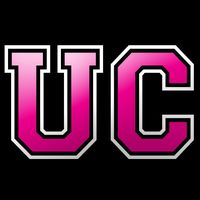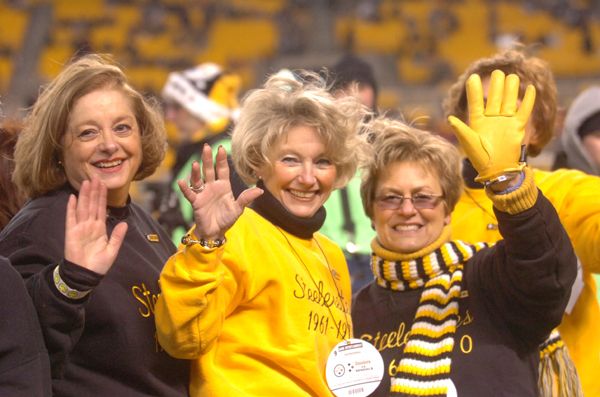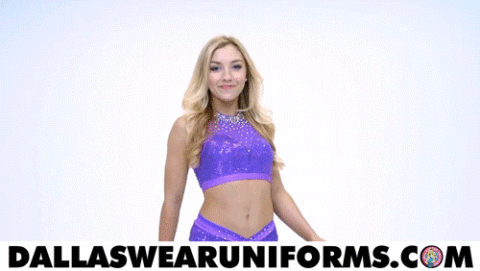Area Woman Part Of Steelerettes Tribute Before Game Against Bengals On Sunday Night
By Konstantine Fekos
Meadville Tribune
Carolyn Crandall (far right) waves during a pre-game ceremony at Heinz Field in Pittsburgh on Sunday. Crandall, then Peterson, was part of the 1968-69 Steelerettes squad
Action on the field, bright stadium lights and fellowship from the Rah-Rah Sisterhood all made Conneautville’s Carolyn Crandall feel like a celebrity at Heinz Field when she was recognized as an alumna of what’s said to be the NFL’s first cheerleading squad Sunday night.
“I just felt like I was on top of the world,” she said. “It was fabulous.”
Crandall was acknowledged with about 15 of the former Steelerettes, the collegiate cheerleaders who spurred the team on during its 1960s seasons.
“They were probably the first NFL cheerleaders,” Crandall said. “They were girls who attended Robert Morris (School of Business) at the time and went to all of the home games.”
The Steelerettes, commissioned by then-owner Art Rooney Sr., predated the Terrible Towel and Three Rivers Stadium, when the Steelers shared Forbes Field and University of Pittsburgh’s Pitt Stadium.
Sunday’s homecoming celebration brought former Steelerettes back on the field to lead the Terrible Towel Twirl pregame before the Steelers hosted the Cincinnati Bengals.
The ladies were joined by renowned former Steelers Franco Harris and Mel Blount, who served as honorary team captains.
The festivities are part of the larger NFL Homecoming initiative, which organizes efforts to reconnect football legends with their former teams and current fans.
“It was entirely an experience I will never forget,” Crandall said. “A once-in-a-lifetime experience.”
Crandall, a Meadville High School and Robert Morris graduate, now working as a sales order processor and logistics coordinator for Ainsworth Pet Nutrition in Meadville, looks back on her days with the Steelerettes quite fondly.
She recalled squad tryouts involving a considerable amount of Robert Morris students, all hoping to be one of the select few to cheer alongside the 1960s Steelers.
“You had to compete with the other girls for a spot; there were quite a few trying out,” she said. “It was a nice accomplishment, I felt, to be selected as one of them.”
Crandall’s mother would drive her down to Pittsburgh twice a week during the summer before her college career to practice choreographed routines with the Steelerettes, she recalled.
“I was a varsity cheerleader for four years at Meadville High School, so it was right up my alley,” Crandall said. “Cheerleading was huge back in those days. You were either a cheerleader or a baton twirler or something of that nature.”
Crandall cheered for the 1968-69 season and still has the Steelerettes squad jacket to prove it.
“I remember being down on the field and feeling so tiny and small; when these guys would run by you, they’d look enormous,” she said. “When you heard the tackle and how they hit, you felt lucky to be standing back. Those guys were like freight trains.”
Although her cheerleading career came to a close during the dry spell before the Steelers’ successful 1970 season, Crandall nonetheless enjoyed her days with the Steelerettes and attends reunion functions when she can.
“When I was younger it was a big deal,” she said. “My mom and dad both saw me on TV a couple times. It was a thrill for them to see me there.”
Other NFL teams must’ve been thrilled as well, because the idea of cheer squads began to take off in the 1970s, but without the wholesome collegiate image the Steelerettes projected, Crandall said.
“Cheerleaders back then were cheerleaders,” she said. “Bobby socks, saddle shoes, vests and sweaters or whatever with pom-poms and skirts past the knee. Now they wear these skimpy outfits.”
The traditional Steelerette look is still on display by uniform at the Heinz History Center.
As Robert Morris evolved over the years from a two-year school into a full-fledged university, interest in national teams supposedly waned and cheerleaders began accompanying new collegiate teams onto school fields and basketball courts.
By eventual joint decision between the Rooneys and RMU, the 1969-70 season would be the last time the Steelerettes entertained a crowd as an official NFL squad, though their sisterhood lives on through the women who still keep in touch today.
“A lot of people say, ‘Oh, the Steelers never had cheerleaders,’” Crandall said. “I just chuckle and say that we were the first.”




